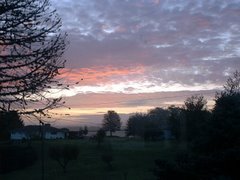So, I learned something today. I had thought where I live the climate zone per USDA Hardiness chart was in zone 8-9. Ahh, but I found the below today which points out my maritime environment puts me more in line with Zone 5. Now I will adjust my planting times accordingly. Also, it's April 1, and I'm eager to start the seedlings, and I learned something else about planting some of the vegetables too early. (Lietta)From Washington state Master Gardener's website;
Everything can go into the ground now, except the heat loving crops like tomatoes, peppers, beans, squash, cukes, corn and basil.Sunset Climate Zones, Oregon State Univ., LANDSCAPE PLANTS
Sunset's Climate Zones
In the
Sunset Western Garden Book (1996, 2001, Sunset Pub. Corp., Menlo Park, Calif.), the western U.S. is divided into 24 Climate Zones. These Climate Zones do NOT correspond to the USDA Hardiness Zones.
Sunset's Climate Zones are based on winter minimum temperatures, but also include other factors such as summer high temperatures, length of growing season, humidity, and rainfall. This approach is used to avoid the difficulties encountered when the USDA Hardiness Zones are applied to parts of the western U.S. For example, with the USDA Hardiness Zones, the Olympic rain forest in Washington State is in the same Hardiness Zone, Zone 8, as part of Arizona's Sonora Desert. Seven
Sunset Climate Zones are used to cover Oregon, Washington, and Idaho. They are:
Zone 1Coldest Winters in the West In this Zone, snow falls and stays on the ground (from a day to all winter) and the growing season is from 75 to 150 days, but frost may occur on any night of the year. The Cascades and most of Central and Eastern Oregon are in this Zone, including the Oregon cities of Bend, Redmond, Burns, etc.Zone 2Second-Coldest Western Climate Here snow is expected but the average annual winter temperatures are higher than in Zone 1; they range from -3o to -34o F. A few lower elevation sites in Eastern Oregon, such as LaGrand and Baker City, are in Zone 2, as are Spokane and Pullman, Washington, and Salt Lake City, Utah.Zone 3Mildest of High-Elevation and Interior Climates This Zone is often called the "banana belt" since the winter are fairly mild, but minimum temperatures may range from 13o to -24o F. The growing season can be shorter than in Zone 2, but the winter temperatures are always higher. Oregon's Coastal Mountains, as well as the Oregon cities of Hood River, The Dalles, Pendleton, and Ontario, and Boise, Idaho, have Zone 3 climates.Zone 5
Marine Influence Along the Northwest Coast Mild ocean air bring relatively warm winters in this Zone. Minimum temperatures range from 28o to 1o F, although in some year a "big freeze" can cause considerable damage to plants. Zone 5 extends from the Puget Sound area in Washington, including Seattle and Tacoma, south along the Pacific Coast to north of Brookings, Oregon, including Astoria, Newport, Coos Bay.Zone 6Willamette Valley Warmer summers distinguish this Zone from Zone 5, average temperatures being 5o to 9o F higher. Average winter lows are similar or lower than those of Zone 5. Much of the Valley has a long growing season, with 279 days in Portland. However, Portland may also experience icy winds blowing down the Columbia. Zone 6 extends from Longview, Washington to Roseburg, Oregon. This of course includes Salem, Corvallis, and Eugene, Oregon.Zone 7Oregon's Rogue River Valley: This Zone has hot summers and mild but pronounced winters. Typical winter lows range from 23o to 9o F, record lows vary from 15o to -1o F. The Oregon cities of Grants Pass, Medford, and Ashland are in Zone 7.Zone 17Marine Effects in Extreme Southwestern Oregon and Northern California A narrow strip along the Coast between Gold Beach and Brookings, Oregon is in this Zone (as is the Coast of Northern California and much of the Bay Area). posted by Lietta Ruger







No comments:
Post a Comment